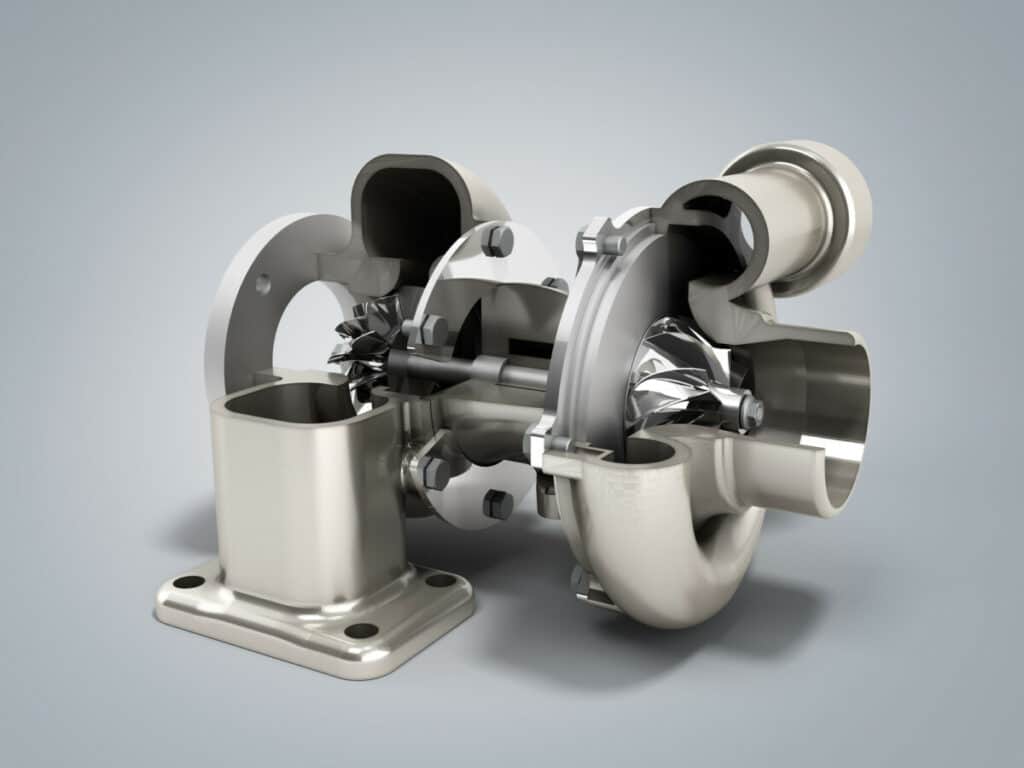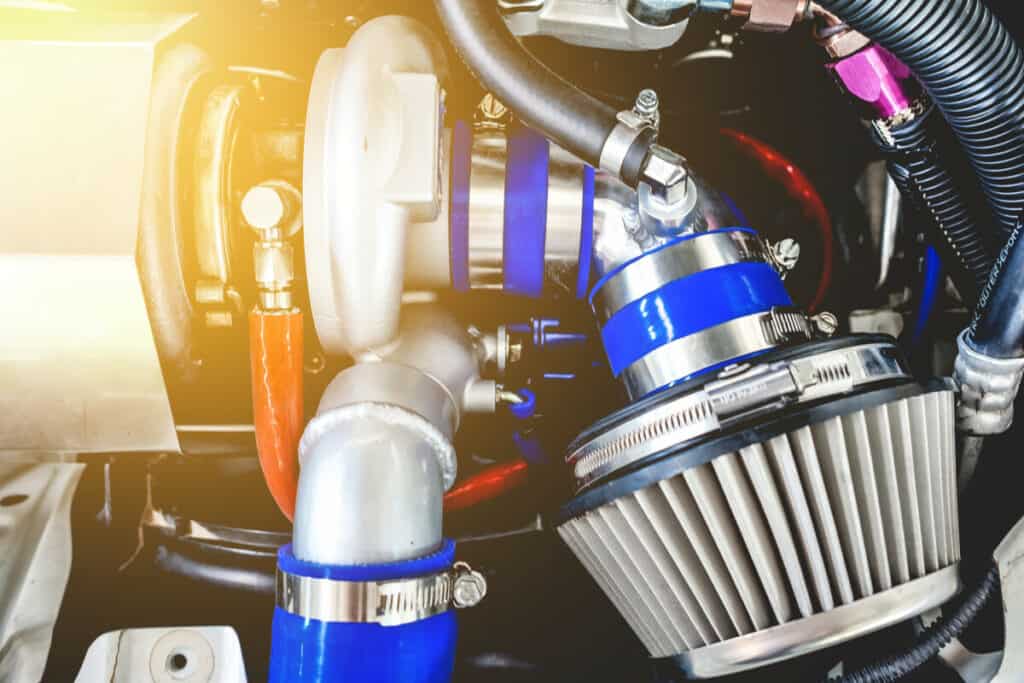Turbos are a fantastic piece of engineering and can completely transform how an engine performs, but like all great things, they can break or give trouble. That’s why knowing exactly how one works is the first step to being able to troubleshoot or fix one yourself, so iv put together this in-depth article covering absolutely everything you need to know about turbochargers.
A turbo works similarly to an air pump, it is made up of two main pieces, the exhaust housing (hot side) and the compressor housing (cold side). Exhaust gasses pass through the exhaust housing which spins a turbine in both sides of the turbo which then compresses the air and forces it into the engine.
In a nutshell, that’s how a turbo works but if you want to take a closer look id encourage you to keep reading because there’s much more to learn.

How a Turbo Works
A turbo is very similar to an air pump, it sucks air in, compresses it, and blows it back out again. Turbochargers can be broken into two sections, the exhaust side (hot side) and the compressor side (cold side), and both of these housings have their own individual turbine wheel.
The turbo is attached to the engine via the exhaust manifold which is bolted to the exhaust side of the turbo. When the exhaust gasses from the engine pass through the hot side of the turbo at a high enough RPM they generate enough energy inside the exhaust housing turbo to spool up (spin) the turbine wheel.
The turbine wheel in the exhaust housing is attached to the compressor wheel in the compressor housing via a common shaft, which means that when one spins the other must also spin. So when the exhaust gasses spin the turbine on the exhaust side of the turbo the compressor wheel on the cold side also spins equally as fast.
The blades of the turbine in the compressor side of a turbo are designed at a certain angle which allows them to grip and draw air into the turbo. The turbine inside of a turbo can reach speeds of over 250,000 RPM, with the turbine spinning at this speed it creates a vacuum at the inlet port of the turbo and sucks in huge amounts of air.
This means that when the compressor wheel is spinning, it is sucking in huge amounts of air from the atmosphere via the air inlet port of the turbo, once this air is inside the compressor housing it is then compressed to a certain PSI, the compressed air is then forced back into your engine at a predetermined pressure or boost via the discharge port of the turbo.
To control how much pressure or boost a turbo generates a wastegate is fitted to the turbo, either internally or externally.
A wastegate is basically a bypass valve. An internal wastegate is a flap inside the exhaust housing of the turbo that opens once boost pressure reaches a certain PSI, once this flap opens, rather than the exhaust gasses passing through the turbo and generating more boost, they will now bypass the turbo and be released into the atmosphere via the wastegate.
The wastegate is controlled by either a spring or an actuator depending on the type of wastegate being used. Once the pressure in the exhaust manifold reaches a certain PSI it will then overcome the tension of the spring which will then open the flap and allow the exhaust gasses to be released into the atmosphere.
If a turbo was allowed to build unlimited boost without being regulated by using a wastegate it would either blow the motor or just not run at all due to the air-to-fuel ratio being too far out of sync, causing the engine to run much too lean and fuel cutting or causing a severe engine knock.
Although there are many different types, sizes, and designs of turbos available they are all either made with ball bearings or a journal bearing. These are the bearings that hold the shaft in place that spins both turbine wheels.
These bearings are lubricated by an oil feed the turbo takes from the engine, without this lubrication the bearings would heat up and seize, or just simply tear themselves apart. That’s why regular oil changes with good quality oil are necessary if you want to prolong the life of your turbo.
Which is Better a Ball Bearing or Journal Bearing Turbo
For street applications, a journal-bearing turbo is a better choice of a turbo, however, it’s a high BHP motor that’s used for track use, where it will be at a high RPM for long durations, a ball-bearing turbo will perform better and have a longer life span than a journal bearing.
The reason for this is because a ball-bearing turbo is designed with a ring of ball bearings inside of a housing surrounding the turbine shaft. These bearings are lubricated by the engine oil, this oil is also able to get between the outside of the bearing and the bearing housing.
This creates a film of oil between the bearing and the housing which allows the bearings to float rather than make direct contact with the housing, this oil also acts as a damper between the turbo housing and the shaft which absorbs vibrations and shocks caused by driving conditions, etc.
This means that the bearing is capable of withstanding the huge G-force created inside the turbo under full boost over long durations.
The downside to this is that if you fail to maintain your turbo correctly over about eighteen months the oil inside the turbo will begin to coke to the inside of the housing. Coking is when the oil burns onto the surface leaving a burnt, hard unsmooth surface.
When this happens it prevents the bearings from floating freely in the housing and on the shaft and instead they end up semi-locked and skidding rather than floating, this also affects how much vibrations are now absorbed by the turbine shaft and not the film of oil.
Once this happens the life of the turbo is significantly shortened and unless fixed it would soon cause catastrophic failure to the turbocharger.

The best way to prevent this from happening is to use the correct shutdown and start-up procedures when you’re driving a turbo car.
To warm up a turbo car you simply leave the engine to idle for at least one minute, or until you see the temperature gauge begin to rise, then you should drive the car at moderate speed until the engine has warmed up to normal operating temperature.
To let a turbo car cool down you should leave the engine to idle for a minimum of thirty seconds before shutting it off, this allows the oil to continue to circulate around the engine and turbo, thereby cooling down the oil and turbo before shutting off the engine.
A common reason for turbo failure is because people fail to follow these procedures. When you shut the engine off immediately after driving, the hot oil inside the turbo stops circulating and just sits inside the turbo cooking to the hot housing, just like if you put butter on a hot pan and leave it to burn off, it will coke to the pan.
A journal-bearing turbo on the other hand has a center shaft that is held in place using oil pressure instead of a ball bearing. Journal-bearing turbos need a good constant supply of oil to the turbo to create the oil pressure needed to carry the shaft.
The good thing about journal-bearing turbos is that due to the high flow of oil they receive, they can cool down a lot faster than a ball-bearing turbo, because the flow of oil can carry the heat away from the turbo, unlike with a ball-bearing turbo where only a minimal amount of oil is needed to lubricate the ball bearing.
The downside to this is that if you lose oil pressure for any reason the turbo will disintegrate. This is because the shaft will no longer be free to spin and it will just collide with the turbo housing causing catastrophic damage to the turbo.
The price difference between a ball bearing and journal bearing turbo can be eye-watering, that’s another reason why a journal bearing is more than good enough for street applications simply because on the street you will generally be in a lower rev range and not create enough G-force to damage a journal bearing turbo.
Should You Use an Internal or External Wastegate Explained
Wastegates are used as a bypass valve to release exhaust gasses into the atmosphere before they reach the turbo. This is done with either an internal or external wastegate.
A turbo with an internal wastegate has a small hole in the exhaust housing which is shut closed using a flap. This flap is mechanically opened and closed using a pneumatic actuator which is controlled by a spring.

This spring is wound to a predetermined tension. For example, a 10 PSI has a minimum limit of 10 PSI before it will open. This means that 10 PSI is the minimum amount of boost the turbo will generate. A common misconception is that the wastegate spring controls the boost output, which is false.
The wastegate spring only controls the minimum amount of boost a turbo makes not the actual boost output of the turbo.
Once the spring opens it then operates an arm that is connected to the flap inside the exhaust housing, once the flap opens, the exhaust gasses can bypass the turbo and be released into the atmosphere.
The downside of an internal wastegate is that you are limited to the size of the wastegate due to it being made as part of the turbo housing.
This can be an issue if you’re making maximum power at high RPM because the wastegate can be too small and result in problems like over boosting due to all of the exhaust gasses not being able to bypass the turbo through the small wastegate opening.
That is why an external wastegate is more commonly used, especially in performance applications because you have control over the size of the wastegate you use and which spring size you need for your specific needs.
External wastegates are located on the exhaust manifold, this means that you need a manifold that is designed for an external wastegate because there needs to be a port coming off the manifold that the wastegate can attach to.
Once the spring inside the wastegate reaches its PSI limit it will open a valve which will allow the exhaust gasses to escape through the wastegate rather than pass through the turbo.
A common problem I see with external wastegates is that they are positioned incorrectly. The wastegate should be pointing in the direction of the flow of exhaust gas, if its positioned at ninety degrees or more to the manifold when the valve opens a lot of the exhaust gasses can flow past the wastegate and proceed into the turbo causing over-boosting and other issues if left unfixed.
Why are Turbos Used
Turbochargers are most commonly used today due to car manufacturers needing to reduce emissions and meet certain targets. This meant they needed to come up with a solution to keep emissions down while not needing to sacrifice power or drivability in the process.
The solution was utilizing a turbocharger. The benefit of this is that you can greatly reduce the size of an engine which would in turn reduce the emissions generated from petrol and diesel engines.
To replace the cylinder displacement they lost by reducing the engine size, they installed a turbocharger to replace the lost displacement by means of forced induction.
Turbos are also used in the motorsport world to massively increase the horsepower of an engine due to the huge amounts of air a turbocharger can force into the engine. Because more air plus more fuel equals more power.
How Does a Turbo Create Power
In order to get more power from an engine, you need to increase its supply of two things, air, and fuel.
By installing a turbocharger you are compressing high volumes of air and then forcing that air into the cylinders of the engine at a very high velocity.
A naturally aspirated (NA) or non-turbo engine runs on atmospheric air pressure which is about 14.5 PSI depending on your location, this creates negative pressure in your intake manifold so that when you press the accelerator, the throttle flap opens and the intake manifold sucks in a gulp of air into the cylinders
When you install a turbocharger the air pressure can be double atmospheric pressure which then causes a positively charged intake manifold, that’s why blow-off valves should be fitted to release this positive pressure once you close the throttle plate.
If there is no blow-off valve fitted to a turbo engine, when you release the throttle it will cause a fluttering sound. This is because the positive pressure from the intake manifold is being released back out through the compressor inlet port of the turbo instead of through the valve.
A turbo creates power by sucking huge amounts of air into the compressor housing, compressing it, and then forcing it at high pressure into the engine via the turbo discharge port, hence the name “forced induction”.

To cool the air coming from the turbo into the engine it first passes through an intercooler which cools the air causing it to become denser. This dense air then fills the intake manifold resulting in the intake manifold becoming positively charged with high-pressure air.
This air then enters the cylinders of the engine and mixes with the fuel resulting in the explosion needed to drive the pistons down. The bigger the explosion the more power the engine will have because more air plus more fuel equals more power.
That’s why by installing a turbo you gain full control over exactly how much air your engine receives and when it receives it.
But the main thing to remember is that if you increase the amount of air you give the engine you also need to increase the amount of fuel, if not your engine will run lean, meaning the air-to-fuel ratio will be too high and the motor won’t be receiving enough fuel to stay running correctly and may cause a severe engine knock.
The 6 Different Types of Turbos
Turbos come in many different shapes and sizes and choosing the correct one to suit your needs is important, so ill go through how each one works and the pros and cons of each.
Single turbo
A single turbo is the most common setup found on most cars today. This is the simplest turbo setup to design, produce and maintain and they also come in a huge range of sizes which is measured by an AR ratio, AR stands for the area of the inlet port by the radius of the turbine.
The higher the AR ratio means the higher the airflow through the turbo, the downside to higher airflow is that it creates more turbo lag because it takes much more exhaust gasses to fill the turbo housing.
Turbo lag is the delay you feel from the time you press the accelerator to the time the car actually begins to accelerate. This is due to the length of time it takes your turbo to fill with a sufficient amount of exhaust gasses and then the length of time it takes to compress and deliver that air from the turbo into the cylinders.
Pros:
- Simple design
- Low maintenance
- Comes in a range of sizes
Cons:
- Turbo lag
Parallel Twin turbo
Twin-turbo is pretty much the same as single turbo only it has a second turbo either connected in parallel or sequentially, the most common and simple way being in parallel.
Twin turbos that are connected in parallel are used on V block motors with each turbo feeding its own cylinder bank with air exactly like a single turbo would feed a four-cylinder.
Sequential twin turbo
Sequential twin turbos are connected using a bypass valve, at low RPM the bypass valve going to the second turbo will be open, allowing the first turbo to receive all the exhaust gasses which will allow it to spool up faster.
Once the RPM has reached a certain point the bypass valve will close and allow the exhaust gasses into both turbos giving you twice the power.
The benefit of this is that you could use two smaller-size turbos which would cut down on turbo lag and still give you more power due to having a second turbo.
Pros:
- More boost due to having a second turbo
- Smaller AR ratio turbos can be used to reduce lag
Cons:
- Expensive
- More complex to setup
- Turbo lag is still present
- Two of the same size turbos must be used
Twin scroll
A twin-scroll turbocharger is divided into different sections or channels. The exhaust manifold is also divided into two different sections with two scrolls of the manifold going to the there own two ports on the turbo and the other two scrolls going to two different ports on the turbo.
The ports on the turbo consist of two big ports and two small ports. The reason for this is that at low RPM the valve between the big and small ports is closed which sends all the exhaust gasses into the small ports creating a higher velocity of air inside the turbo at low RPM.
Once the engine reaches a higher RPM the bigger ports of the turbo open up which allows a much larger capacity of air to flow through the turbo. This is an excellent way of reducing turbo lag.
Pros:
- More throttle response
- More fuel efficient
- Less turbo lag
Cons:
- Expensive to buy
- More hardware needed such as a twin scroll exhaust manifold
Variable geometry turbo
A variable geometry turbo is similar to the twin-scroll with regards to being designed to reduce turbo lag. This type of turbo is designed with a ring of veins surrounding the exhaust housing. These veins are on pivot points and are operated open and shut by an actuator.
At low RPM the actuator closes the veins creating a higher velocity of air to enter the turbo there by spooling up the turbine faster which will then reduce turbo lag. Once the engine reaches high RPM the veins open up fully allowing the maximum allowable amount of gas to enter the turbo.
This turbo does a brilliant job of reducing turbo lag at low RPM but due to the stress and heat, these small moving veins are exposed to means they need to be made from exotic materials which are expensive and quite soft.
That’s the reason these turbos are mainly only used in diesel engines due to the diesel compression engine being far easier on parts than an ignition petrol engine.
Pros:
- Excellent at reducing turbo lag
- More responsive acceleration
- More fuel efficient
Cons:
- Very expensive
- Only suitable for diesel engines
Electric turbo
Electric turbochargers are becoming ever more common on production cars in the past couple of years and they work similarly to a traditional turbo.
The difference with an E-turbo is that instead of using exhaust gasses to spool up the compressor it instead uses an electric motor which is activated by pressing the accelerator pedal.
The benefit to this is that it practically eliminates turbo lag due to the compressor instantly reaching full speed, unlike a traditional turbo which needs to reach a certain RPM before enough exhaust gasses are produced to create a sufficient amount of boost.
The downside to electric turbochargers is that they are designed for reaching maximum performance, which means fuel consumption wasn’t on the engineer’s mind when designing this turbo.
Pros:
- Turbo lag is eliminated
- Faster acceleration
Cons:
- Fuel consumption is worse than a traditional turbocharger
- Expensive and complicated to install and tune
- More moving parts to go wrong (motors)
Who Invented Turbos
In 1905 a Swiss Engineer by the name of Alfred Buchi built and designed the first turbocharger prototype.
Recent Posts
As much as I and everyone else love turbochargers there is one problem most people have with using them, turbo lag. Turbo lag is a hesitation or unresponsiveness which may be felt as a slow...
Last week a friend of mine arrived in my shop with a Garrett 3076R turbocharger and asked me if I could install it in a stock Miata MX5 because he wanted to more power out of corners on the track....
